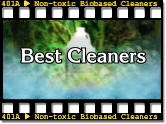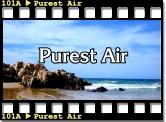
|
|
|
OVERVIEW
OF INDOOR AIR QUALITY ISSUES
Part
3 –
What We Don’t Know
but Should Know
about the Air
We Breathe –
D.
What Are We Breathing?
5. VOC's

|
| 5.
Chemicals/Smoke/VOC's. |


If
we can understand something of the mechanics of how odors originate and
spread through air, we can begin to make sense of the concerns
regarding "Volatile Organic
Compounds" or "VOC's"
for short.
VOC's
can originate from natural sources such
as rotting vegetation or animal matter. They may also come from man
made sources. Of special concern are those derived from
some form of petroleum or petroleum derivative, known in the industry
as "petroleum distillates" or "petrochemicals".
|
Regardless
of source, VOC's may range from mildly noxious to lethal,
depending both on the type of material and the amount of the exposure.
Some naturally occurring VOC's, such as radon
or methane gas, can be quite debilitating
or dangerous.
And
reading the Material Safety Data Sheets ("MSDS")
on many fairly common household products should cause a great deal of
caution or alarm. |

Spectral analysis of the VOC emissions from
building materials in a newly finished room. |
|
VOC's
may or not have a discernible odor
to alert one to their presence and possible danger. For instance, natural
gas is naturally odorless yet terribly deadly.
Government regulations require that a foul smelling substance is added
to the gas to let us know when gas may be present and warn of its
dangers. Other VOC's do give off warning smells, initially, but with
the proliferation of so many artificial substances, we
have overwhelmed our discerning sensitivities and gotten accustomed to
dealing with myriads of potentially harmful odors.
One way we have done so is
by means of the surface and room odorants we so quickly and
thoughtlessly use. Another way is by means of a natural response
whereby, after
prolonged exposure, our olfactory systems often cease to recognize the
presence of constant odors. In neither case does it
mean that the VOC's have gone away or that they no longer pose a
threat. It just means that we do not give them the attention they
deserve.
|
|
With
today's building materials and products, it is almost like having a
chemical plant right in your own living room!
|
What
are typically branded as V.O.C.'s and of the most concern are usually
found indoors in the off gassings given by synthetic
carpet, paints, finishes,
furniture, circuit
boards, household and commercial cleaning
products, insecticides, synthetic
surfaces, particle wood products,
and thousands of other common household and commercial items. They
are of special concern in indoor environments where the same air is
constantly re-circulated and the concentrations of
the emitted gases can build. New
construction is especially notorious for
bringing together numerous products and substances known to be at their
most volatile (and dangerous) state, though the emission of micro
particles will continue almost indefinitely throughout the lifetime of
the product. |
Likewise,
new cars
are known for their characteristic "new car smell" generated by the
combination of VOC's from the numerous synthesized
materials they contain. While that smell is typically
linked to the pleasant experience of acquiring new transportation, its
presence may not be altogether benign.
|
| Further
complications arise when gases of certain chemicals which singly may
have little or no toxic effect combine with other chemical gases and
create new compounds which are toxic to some degree, whether
mild or severe. Multiple combinations of these new gaseous compounds
(referred to in the IAQ community as "toxic soups") can have a combined
net effect which is very hazardous in a closed indoor environment. It
is no doubt one of the reasons that the US EPA has stated that we are
five times more likely to get cancer from our indoor environments than
by any of the pollution exposures we would get out of doors. |

No
IAQ plan is complete which does not address the reduction,
neutralization, or elimination of VOC's. |
Dangerous
Chemicals One Inch from Your Baby
 Dangerous
chemicals that could possibly cause fertility and hormonal problems for
your baby boy are only an inch away when he sleeps. Phthalate chemicals
used in the production of crib mattresses are linked to reproductive
and liver damage, asthma, allergies and malformations. Dangerous
chemicals that could possibly cause fertility and hormonal problems for
your baby boy are only an inch away when he sleeps. Phthalate chemicals
used in the production of crib mattresses are linked to reproductive
and liver damage, asthma, allergies and malformations.
Phthalates
are chemicals used in the manufacture of vinyl that make products soft
and flexible. They are classified as endocrine disrupters, which are
synthetic chemicals that either mimic or block hormones when absorbed
into the body or disrupt bodily functions. Over time, the chemicals
leach out of the vinyl, causing it to become brittle and crack.
Although
phthalates are used in hundreds of everyday objects, from plastic wrap
to personal care products, perhaps the most troubling uses are in
products that are closest to babies for much of their young lives.
Although manufacturers voluntarily eliminated phthalates from baby toys
that go directly into an infant’s mouth, they are still used
in the
manufacture of other toys. They are also found in large amounts in crib
mattresses and waterproof pads. These items constantly exude harmful
phthalates that are breathed in by babies for ten or more hours a day
for two or more years.
A study released in 2005 found that the
baby boys of moms who were exposed to the largest amounts of phthalates
during pregnancy had smaller penises and were more likely to have
undescended testicles. This study backed up earlier animal studies that
showed phthalates caused “the phthalate syndrome,”
which included a
demasculinization of the male reproductive tract and included lower
sperm counts and testicular tumors as adults.
amounts of phthalates
during pregnancy had smaller penises and were more likely to have
undescended testicles. This study backed up earlier animal studies that
showed phthalates caused “the phthalate syndrome,”
which included a
demasculinization of the male reproductive tract and included lower
sperm counts and testicular tumors as adults.
“Every aspect of
male identity is altered when you see this in male animals,”
said Fred
vom Saal, professor of reproductive biology at the University of
Missouri-Columbia.
Manufacturers are responding to parents’
concerns by offering organic crib mattresses. One company, NaturePedic,
produces crib mattresses using natural materials such as cotton and
eliminates all vinyl and phthalates. Some baby stores are beginning to
stock organic crib mattresses or they can be found online.
|

Next
Heading this Section -->
 

All
materials not supplied by manufacturers or others are
Copyright
2005 - 2014 -- breathe-easier.com -- All Rights Reserved
|
 |
NEW!

Check
out the videos



An introduction to indoor air
quality issues.


B.
What Don't We Know?
--
KWIK FACTS.
The problem is worse than we realize.


C.
What Do We Need to Know?
Sorting out the info and charting
a course to follow.

D.
What are We Breathing?
Unwelcome
guests we receive every time we breathe.
2. Allergens.
The
body’s “hit list” of alien invaders.

3. Pathogens.
The
bacteria, viruses, and germs which reproduce in the human body
and
try to
stage
a
takeover.

4. Odors.
Things
have odors for a reason,
but why?
Can the problem be corrected rather than merely masked or covered up?


5. Chemicals/Smoke/VOC's.
Are we
possibly drowning in a toxic soup?


6. Mold.
Is what we see dangerous?
And is what we don't see
perhaps more dangerous than what we do see?


E.
Which Technology Works the Best?
Are the technologies pretty
much equal, or is their a large disparity among them?


1. Passive Technology.
The pollution finds the solution.
(Or so we hope!)


2.
Active Technology.
The solution finds the pollution -
even where it is hiding!


a. Stage One -- Dual
Ionization (Particulate Removal)


b.
Stage Two -- Quad
Oxidizing Plasmas


c.
Stage Three -- Advanced
Oxidation


d.
Combo Effect -- The
Whole is Greater Than the Sum of its Parts.


3. Major Differences.
Things that are not the same
are not equal.


a. Literally out of this
world.
The technology which produces
"the purest air on the planet"
actually comes from
out of this world.


b. Overall Air Purity.
By what standard do
you certify the actual purity of air?


c. Too Clean to Test for Purity?
"Without dirt in the air,
we cannot tell you
how pure the air is."
Does that strike anybody as odd?


d.
Where's the Dirt?
(Where is Clara Peller
when you need her?)


e. What to do?
Anybody
can see that it’s clean except the career bureaucrats.


f. Where are the Germs?
Hint: One place they are not
is
"Blowin' in the Wind".


g. Filtration rates vs. Kill
rates.
In the war against pathogens,
would you like your germs
captured and contained
or killed "graveyard dead"?


h.
Odor Abatement/Removal.
The
same thing that RCITM
does to
particulates and germs it does also to smoke, dust, and sources of
odors.


F. What IAQ
issues must be considered and addressed?
Head to head comparison of the technologies - very revealing.


G.
Are there medical considerations?
Obligatory disclaimers and the practical realities of what happens when
a sick body can actually catch its breath.


H.
Are there legal and other considerations?
What happens if we just
ignore the problem or fail to investigate it fully?


I.
When is Timing an Issue?
If
the mold or other air quality problem doesn't seem to be spreading or
getting any worse, so we really have to pay it any attention?
 |















































































 Dangerous
chemicals that could possibly cause fertility and hormonal problems for
your baby boy are only an inch away when he sleeps. Phthalate chemicals
used in the production of crib mattresses are linked to reproductive
and liver damage, asthma, allergies and malformations.
Dangerous
chemicals that could possibly cause fertility and hormonal problems for
your baby boy are only an inch away when he sleeps. Phthalate chemicals
used in the production of crib mattresses are linked to reproductive
and liver damage, asthma, allergies and malformations.  amounts of phthalates
during pregnancy had smaller penises and were more likely to have
undescended testicles. This study backed up earlier animal studies that
showed phthalates caused “the phthalate syndrome,”
which included a
demasculinization of the male reproductive tract and included lower
sperm counts and testicular tumors as adults.
amounts of phthalates
during pregnancy had smaller penises and were more likely to have
undescended testicles. This study backed up earlier animal studies that
showed phthalates caused “the phthalate syndrome,”
which included a
demasculinization of the male reproductive tract and included lower
sperm counts and testicular tumors as adults. 

